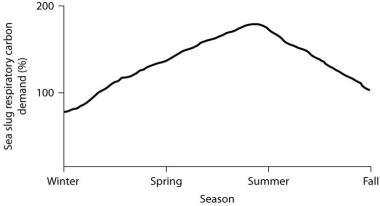Multiple Choice
Use the following graph to answer the questions below.

Percent of sea slug respiratory carbon demand provided by indwelling dinoflagellates.
-The sea slug Elysia chorotica has no nematocysts or dinoflagellates but, rather, has "naked" chloroplasts in its skin. The chloroplasts are all that remain of the seaweed (Vaucheria sp.) that Elysia feeds upon. The chloroplasts are transferred to the skin; consequently, this slug is green. It spends most of its time basking in shallow water on the surface of seaweeds. How should we expect its chloroplasts to benefit the Elysia sea slug? 1. provide Elysia with fixed CO₂
2. provide Elysia with fixed N₂
3. provide Elysia with protective colouration
A) 1 only
B) 2 only
C) 3 only
D) 1 and 3
E) 1, 2, and 3
Correct Answer:

Verified
Correct Answer:
Verified
Q4: In terms of food capture, which sponge
Q13: Which of the following is found only
Q20: Which of the following is true of
Q29: This nudibranch, a type of sea slug,
Q31: This nudibranch, a type of sea slug,
Q46: <img src="https://d2lvgg3v3hfg70.cloudfront.net/TB5463/.jpg" alt=" Percent of
Q56: Use the following graph to answer the
Q60: The heartworms that can accumulate within the
Q62: In incomplete metamorphosis, the young _, while
Q75: How many of the following can be